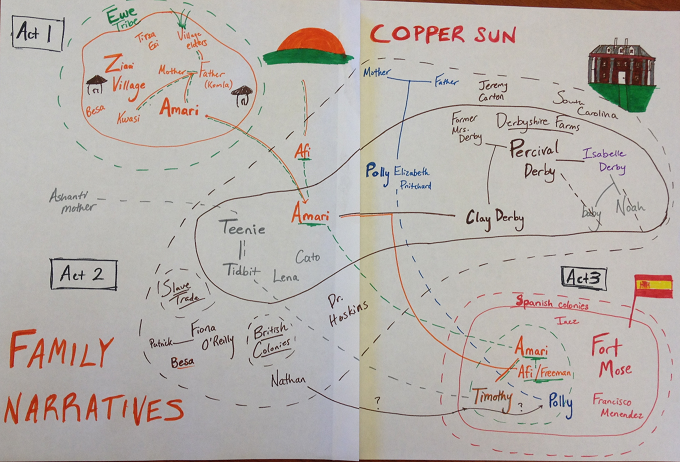Character Map
This character map visually represents the family relationships in Copper Sun and highlights the transmission of family narratives. The solid and dotted circles that enclose the characters represent the social and cultural institutions that influence the values and narratives passed on by families. The colored lines between characters embody the preservation or alteration of family narratives through different stages of the story. For Amari, the continuation of the orange and green colors of her family, village, and tribe illustrates the preservation of her family's identity and culture, which places her and her child back in her family line and brings hope for new life out of orphanhood.
Building Global Awareness
A transcript of a narrative from personal experience shared on Orphan Sunday (November 2, 2014)
When I traveled to Uganda last year to work at Good Shepherd’s Fold Children’s Home in Uganda, I knew little, if anything, about the lived experience of an orphan. When I arrived I realized just how little I knew about the place that I had come to and the people who I had come to live with. I found that I didn’t even have a framework for understanding the experience of an orphan in the Third World, in a culture where one’s place in a family, a village, a tribe largely defines a person. While I still don’t presume to know the loss and uncertainty that being separated from one’s family brings, I now see faces when I hear the faceless term “orphan.”
I slowly learned to listen to the children and the young men and women I had come to share a year of my life with. I learned how to put myself in a position to hear them without trying to “fix” them, to know them without trying to be their Savior.
I heard many perspectives, some that expressed the pain of orphanhood more bluntly than I knew how to process. “I wish my father were still alive so I didn’t have to live here”; “I don’t cry anymore. I don’t have any tears left”; “I think God forgets his children.” The untold stories often carried the most pain.
But I didn’t meet hopeless stories; I met children who laughed, who cried, who played football, who climbed trees, who chased monkeys, who sometimes wanted to run away, who grew gardens, who complained about their chores, who read stories, who sang songs. I met children who gave testimonies of thanksgiving: for their lives, for their brothers and sisters, for their big family at GSF, for God's plan for their life.
I am thankful for the children who I met last year. I am thankful for their stories. I am thankful for the loving family that has been created at GSF. I am thankful for adoption, both physical and spiritual. I am thankful for a Father who brings his children home.
I slowly learned to listen to the children and the young men and women I had come to share a year of my life with. I learned how to put myself in a position to hear them without trying to “fix” them, to know them without trying to be their Savior.
I heard many perspectives, some that expressed the pain of orphanhood more bluntly than I knew how to process. “I wish my father were still alive so I didn’t have to live here”; “I don’t cry anymore. I don’t have any tears left”; “I think God forgets his children.” The untold stories often carried the most pain.
But I didn’t meet hopeless stories; I met children who laughed, who cried, who played football, who climbed trees, who chased monkeys, who sometimes wanted to run away, who grew gardens, who complained about their chores, who read stories, who sang songs. I met children who gave testimonies of thanksgiving: for their lives, for their brothers and sisters, for their big family at GSF, for God's plan for their life.
I am thankful for the children who I met last year. I am thankful for their stories. I am thankful for the loving family that has been created at GSF. I am thankful for adoption, both physical and spiritual. I am thankful for a Father who brings his children home.
The Faces behind the Stories: Portraits of Orphaned and Vulnerable Children
All images © 2014 Stephen Langford. Images may not be reproduced without permission.
Secondary Education:
A lesson plan on oral traditions and family narratives in Copper Sun
| Copper Sun Family Narratives Lesson Plan.docx | |
| File Size: | 16 kb |
| File Type: | docx |
A handout on family heritage in Copper Sun presented at the 2014 North Carolina English Teachers Association Conference (NCETA)
| "Finding 'Home': Navigating Heritage and Identity in Slave Narratives and Multicultural Texts" | |
| File Size: | 127 kb |
| File Type: | |
Photo Credits
Gardner, D., Green, S., Hill, G., Pitt, B., Pohlad, B. (Producers), & Malick, T. (Director). (2011). The tree of life. Retrieved from http://staticmass.net/wp-content/uploads/2012/12/dvd_tree.jpg
Gardner, D., Green, S., Hill, G., Pitt, B., Pohlad, B. (Producers), & Malick, T. (Director). (2011). The tree of life. Retrieved from http://1.bp.blogspot.com/-H7QN3Z30tW4/Tgy8if-TuRI/AAAAAAAADPc/Kwr33TUCHoU/s1600/Tree-of-Life-039.jpg
Gardner, D., Green, S., Hill, G., Pitt, B., Pohlad, B. (Producers), & Malick, T. (Director). (2011). The tree of life. Retrieved from http://www.themodchik.com/wp-content/uploads/2013/01/Tree-of-Life.png
Geisler, R. M., Hill, G., Roberdeau, J. (Producers), & Malick, T. (Director). (1998). The thin red line. Retrieved from http://www.geekexchange.com/wp-content/uploads/2014/05/Thin_Red_large.jpg
Student Conservation Association. Retrieved from https://contest.thesca.org/got-dirt/beautiful-forest-path
Gardner, D., Green, S., Hill, G., Pitt, B., Pohlad, B. (Producers), & Malick, T. (Director). (2011). The tree of life. Retrieved from http://1.bp.blogspot.com/-H7QN3Z30tW4/Tgy8if-TuRI/AAAAAAAADPc/Kwr33TUCHoU/s1600/Tree-of-Life-039.jpg
Gardner, D., Green, S., Hill, G., Pitt, B., Pohlad, B. (Producers), & Malick, T. (Director). (2011). The tree of life. Retrieved from http://www.themodchik.com/wp-content/uploads/2013/01/Tree-of-Life.png
Geisler, R. M., Hill, G., Roberdeau, J. (Producers), & Malick, T. (Director). (1998). The thin red line. Retrieved from http://www.geekexchange.com/wp-content/uploads/2014/05/Thin_Red_large.jpg
Student Conservation Association. Retrieved from https://contest.thesca.org/got-dirt/beautiful-forest-path

